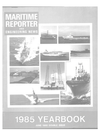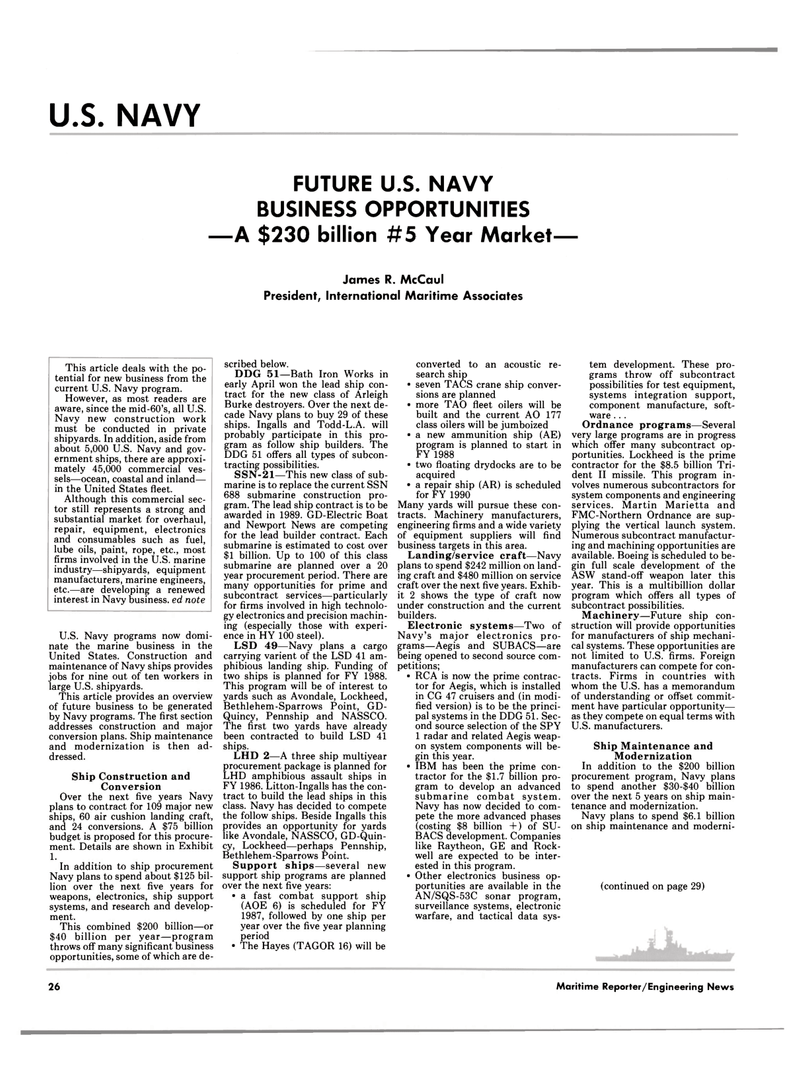
Page 24: of Maritime Reporter Magazine (June 1985)
Read this page in Pdf, Flash or Html5 edition of June 1985 Maritime Reporter Magazine
U.S. NAVY
FUTURE U.S. NAVY
BUSINESS OPPORTUNITIES —A $230 billion #5 Year Market—
James R. McCaul
President, International Maritime Associates
This article deals with the po- tential for new business from the current U.S. Navy program.
However, as most readers are aware, since the mid-60's, all U.S.
Navy new construction work must be conducted in private shipyards. In addition, aside from about 5,000 U.S. Navy and gov- ernment ships, there are approxi- mately 45,000 commercial ves- sels—ocean, coastal and inland— in the United States fleet.
Although this commercial sec- tor still represents a strong and substantial market for overhaul, repair, equipment, electronics and consumables such as fuel, lube oils, paint, rope, etc., most firms involved in the U.S. marine industry—shipyards, equipment manufacturers, marine engineers, etc.—are developing a renewed interest in Navy business, ed note
U.S. Navy programs now domi- nate the marine business in the
United States. Construction and maintenance of Navy ships provides jobs for nine out of ten workers in large U.S. shipyards.
This article provides an overview of future business to be generated by Navy programs. The first section addresses construction and major conversion plans. Ship maintenance and modernization is then ad- dressed.
Ship Construction and
Conversion
Over the next five years Navy plans to contract for 109 major new ships, 60 air cushion landing craft, and 24 conversions. A $75 billion budget is proposed for this procure- ment. Details are shown in Exhibit 1.
In addition to ship procurement
Navy plans to spend about $125 bil- lion over the next five years for weapons, electronics, ship support systems, and research and develop- ment.
This combined $200 billion—or $40 billion per year—program throws off many significant business opportunities, some of which are de- scribed below.
DDG 51—Bath Iron Works in early April won the lead ship con- tract for the new class of Arleigh
Burke destroyers. Over the next de- cade Navy plans to buy 29 of these ships. Ingalls and Todd-L.A. will probably participate in this pro- gram as follow ship builders. The
DDG 51 offers all types of subcon- tracting possibilities.
SSN-21—This new class of sub- marine is to replace the current SSN 688 submarine construction pro- gram. The lead ship contract is to be awarded in 1989. GD-Electric Boat and Newport News are competing for the lead builder contract. Each submarine is estimated to cost over $1 billion. Up to 100 of this class submarine are planned over a 20 year procurement period. There are many opportunities for prime and subcontract services—particularly for firms involved in high technolo- gy electronics and precision machin- ing (especially those with experi- ence in HY 100 steel).
LSD 49—Navy plans a cargo carrying varient of the LSD 41 am- phibious landing ship. Funding of two ships is planned for FY 1988.
This program will be of interest to yards such as Avondale, Lockheed,
Bethlehem-Sparrows Point, GD-
Quincy, Pennship and NASSCO.
The first two yards have already been contracted to build LSD 41 ships.
LHD 2—A three ship multiyear procurement package is planned for
LHD amphibious assault ships in
FY 1986. Litton-Ingalls has the con- tract to build the lead ships in this class. Navy has decided to compete the follow ships. Beside Ingalls this provides an opportunity for yards like Avondale, NASSCO, GD-Quin- cy, Lockheed—perhaps Pennship,
Bethlehem-Sparrows Point.
Support ships—several new support ship programs are planned over the next five years: • a fast combat support ship (AOE 6) is scheduled for FY 1987, followed by one ship per year over the five year planning period • The Hayes (TAGOR 16) will be converted to an acoustic re- search ship • seven TACS crane ship conver- sions are planned • more TAO fleet oilers will be built and the current AO 177 class oilers will be jumboized • a new ammunition ship (AE) program is planned to start in
FY 1988 • two floating drydocks are to be acquired • a repair ship (AR) is scheduled for FY 1990
Many yards will pursue these con- tracts. Machinery manufacturers, engineering firms and a wide variety of equipment suppliers will find business targets in this area.
Landing/service craft—Navy plans to spend $242 million on land- ing craft and $480 million on service craft over the next five years. Exhib- it 2 shows the type of craft now under construction and the current builders.
Electronic systems—Two of
Navy's major electronics pro- grams—Aegis and SUBACS—are being opened to second source com- petitions; • RCA is now the prime contrac- tor for Aegis, which is installed in CG 47 cruisers and (in modi- fied version) is to be the princi- pal systems in the DDG 51. Sec- ond source selection of the SPY 1 radar and related Aegis weap- on system components will be- gin this year. • IBM has been the prime con- tractor for the $1.7 billion pro- gram to develop an advanced submarine combat system.
Navy has now decided to com- pete the more advanced phases (costing $8 billion + ) of SU-
BACS development. Companies like Raytheon, GE and Rock- well are expected to be inter- ested in this program. • Other electronics business op- portunities are available in the
AN/SQS-53C sonar program, surveillance systems, electronic warfare, and tactical data sys- tem development. These pro- grams throw off subcontract possibilities for test equipment, systems integration support, component manufacture, soft- ware .. .
Ordnance programs—Several very large programs are in progress which offer many subcontract op- portunities. Lockheed is the prime contractor for the $8.5 billion Tri- dent II missile. This program in- volves numerous subcontractors for system components and engineering services. Martin Marietta and
FMC-Northern Ordnance are sup- plying the vertical launch system.
Numerous subcontract manufactur- ing and machining opportunities are available. Boeing is scheduled to be- gin full scale development of the
ASW stand-off weapon later this year. This is a multibillion dollar program which offers all types of subcontract possibilities.
Machinery—Future ship con- struction will provide opportunities for manufacturers of ship mechani- cal systems. These opportunities are not limited to U.S. firms. Foreign manufacturers can compete for con- tracts. Firms in countries with whom the U.S. has a memorandum of understanding or offset commit- ment have particular opportunity— as they compete on equal terms with
U.S. manufacturers.
Ship Maintenance and
Modernization
In addition to the $200 billion procurement program, Navy plans to spend another $30-$40 billion over the next 5 years on ship main- tenance and modernization.
Navy plans to spend $6.1 billion on ship maintenance and moderni- (continued on page 29) 26 Maritime Reporter/Engineering News

 23
23

 25
25
